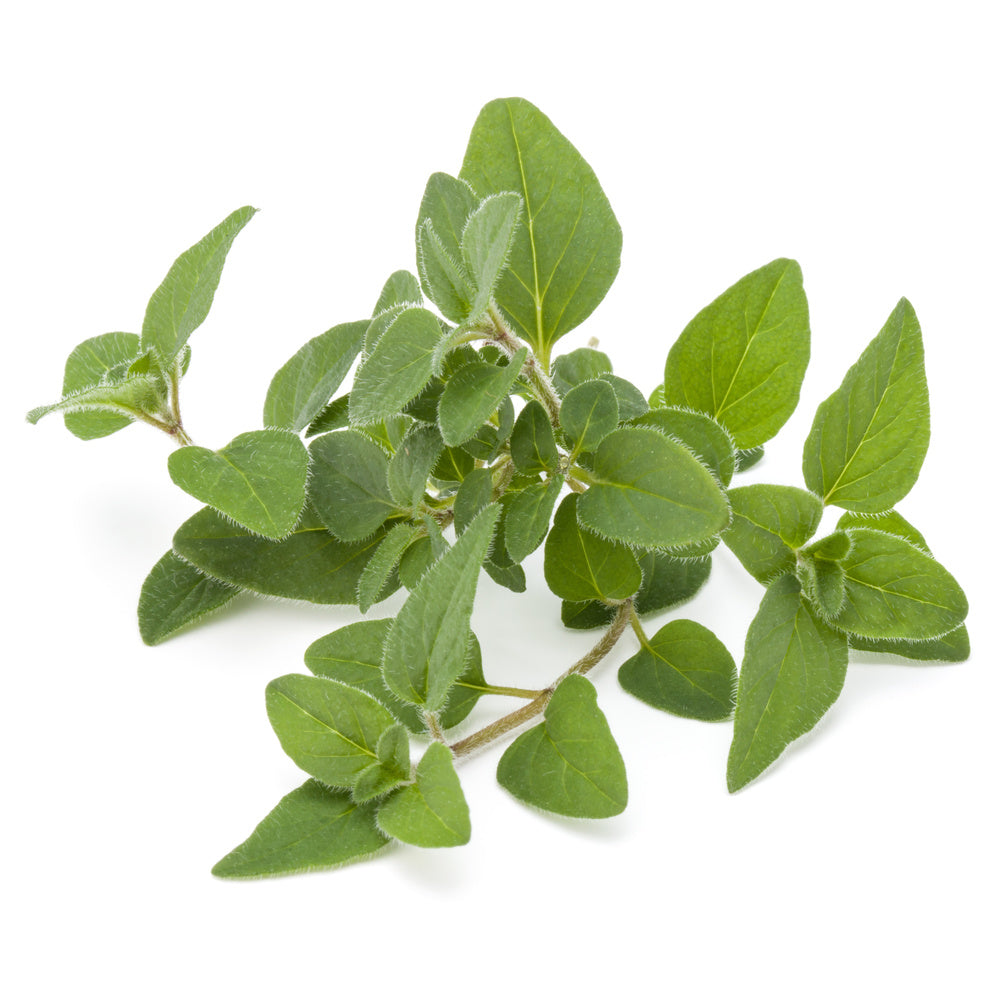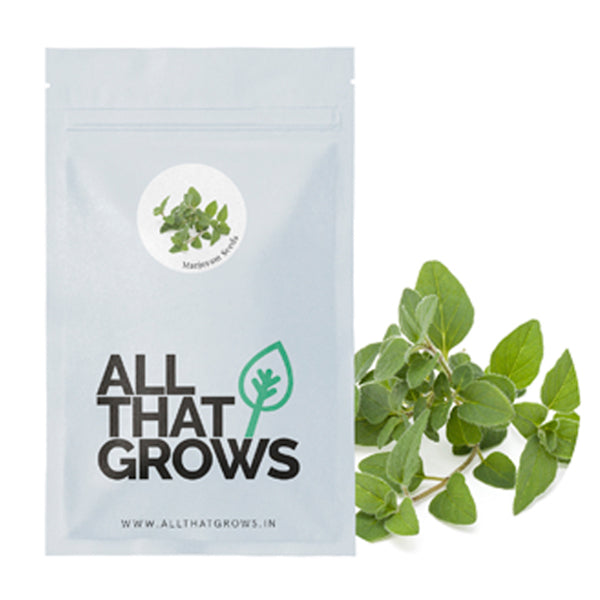



- SOWING
TIMEMarch to May
- Sowing
DistancePlant to Plant - 10-12 inches, Line to Line - 20 to 22 inches
- Fruit
WeightN/A
- Fruit
ShapeN/A
- Days to
maturity80 to 90 days
- Details
- How to sow
- Reviews
Though many confuse this distinctly flavourful herb for oregano, the floral notes and taste of this herb sets it apart from somewhat pungent relatives like oregano. A member of the mint family, Marjoram is a subspecies of Oregano plant. The citrus and floral flavours of Marjoram make it ideal for use in both sweet and savory recipes. Marjoram is believed to have originated in the Mediterranean and grows to a bushy shrub. The leaves of Marjoram tend to be slightly more round than oval and grow in pairs. Marjoram contains vitamins A, C, iron, calcium and also has anti-bacterial, anti-inflammatory, anti-fungal properties. Marjoram can be used in sauces, marinades, and also pairs well with fruits and desserts. The essential oil from the herb is also used in the cosmetics industry.
Planting instructions
Start the tiny seeds indoors after the last frost has passed. Sow the seeds at a depth of ¼ inches in loose and well draining soil. Marjoram is rather slow to germinate and can take upto 14 to 18 days in optimum soil temperature. Transplant the seedlings outdoors after hardening off in a sunny location. Marjoram can also be grown well in containers and is a great companion plant for most of the herbs.
Growing Requirements
pests
Some common pests that can affect the Marjoram plant are aphids and spider mites which can be corrected with a neem oil spray. And like most herbs, Marjoram is also prone to damping off and root rot in wet soil.
soil
Marjoram grows well in loose well-drained soils with a pH ranging from 6.5 to 7.
spot
Marjoram plant is best planted in a spot that receives 4-5 hours of sunlight everyday.
temperature
Marjoram grows best in temperate climates and the ideal soil temperature for germination of seeds ranges between 18 to 21℃.
watering
Keep the soil evenly moist till the time the roots of the plant have established. After that, watering frequency can be reduced to alternate days. Wet soil can cause the herb to lose some of its flavours.
how to harvest
Marjoram will be most flavourful in warm weather and just prior to flowering. Marjoram can be harvested once the plant is 8 to 10 inches tall. Snip the leaves from the branches and use fresh or dry in a paper towel to store in the refrigerator for 4-5 days. Marjoram can also be dried and stored in an airtight container for prolonged usage.

Customer Reviews
The productiveness of any seed we sell is subject to your local climatic conditions*, the sowing method you adopt, and your commitment to the planting process. We give no warranty, expressed or implied, and are in no way responsible for the produce.
Please note that all our seasonal recommendations/ sowing information is as per the local climatic conditions. *For more information on the optimum conditions required for growing seeds in your region, please contact us at, hello@allthatgrows.in or Whatsapp us at, +91 8544865077
Questions & Answers
Have a Question?
Be the first to ask a question about this.




Marjoram Seeds
Seed Type : Non-Hybrid, Open Pollinated and Non-GMO
SOWING TIME : March to July
PLANT CHARACTER : Shrub like herb grows upto 25 to 35 inches
LEAF CHARACTER : Light green, slightly oval fuzzy textured
HARVEST : 80 to 90 days after sowing
Grow this with
Though many confuse this distinctly flavourful herb for oregano, the floral notes and taste of this herb sets it apart from somewhat pungent relatives like oregano. A member of the mint family, Marjoram is a subspecies of Oregano plant. The citrus and floral flavours of Marjoram make it ideal for use in both sweet and savory recipes. Marjoram is believed to have originated in the Mediterranean and grows to a bushy shrub. The leaves of Marjoram tend to be slightly more round than oval and grow in pairs. Marjoram contains vitamins A, C, iron, calcium and also has anti-bacterial, anti-inflammatory, anti-fungal properties. Marjoram can be used in sauces, marinades, and also pairs well with fruits and desserts. The essential oil from the herb is also used in the cosmetics industry.
Seed Type : Non-Hybrid, Open Pollinated and Non-GMO
SOWING TIME : March to July
PLANT CHARACTER : Shrub like herb grows upto 25 to 35 inches
LEAF CHARACTER : Light green, slightly oval fuzzy textured
HARVEST : 80 to 90 days after sowing
- SOWING
TIMEMarch to May
- Sowing
DistancePlant to Plant - 10-12 inches, Line to Line - 20 to 22 inches
- Fruit
WeightN/A
- Fruit
ShapeN/A
- Days to
maturity80 to 90 days
Planting instructions
Start the tiny seeds indoors after the last frost has passed. Sow the seeds at a depth of ¼ inches in loose and well draining soil. Marjoram is rather slow to germinate and can take upto 14 to 18 days in optimum soil temperature. Transplant the seedlings outdoors after hardening off in a sunny location. Marjoram can also be grown well in containers and is a great companion plant for most of the herbs.
Growing Requirements
pests
Some common pests that can affect the Marjoram plant are aphids and spider mites which can be corrected with a neem oil spray. And like most herbs, Marjoram is also prone to damping off and root rot in wet soil.
soil
Marjoram grows well in loose well-drained soils with a pH ranging from 6.5 to 7.
spot
Marjoram plant is best planted in a spot that receives 4-5 hours of sunlight everyday.
temperature
Marjoram grows best in temperate climates and the ideal soil temperature for germination of seeds ranges between 18 to 21℃.
watering
Keep the soil evenly moist till the time the roots of the plant have established. After that, watering frequency can be reduced to alternate days. Wet soil can cause the herb to lose some of its flavours.
how to harvest
Marjoram will be most flavourful in warm weather and just prior to flowering. Marjoram can be harvested once the plant is 8 to 10 inches tall. Snip the leaves from the branches and use fresh or dry in a paper towel to store in the refrigerator for 4-5 days. Marjoram can also be dried and stored in an airtight container for prolonged usage.



 Sign In
Sign In








